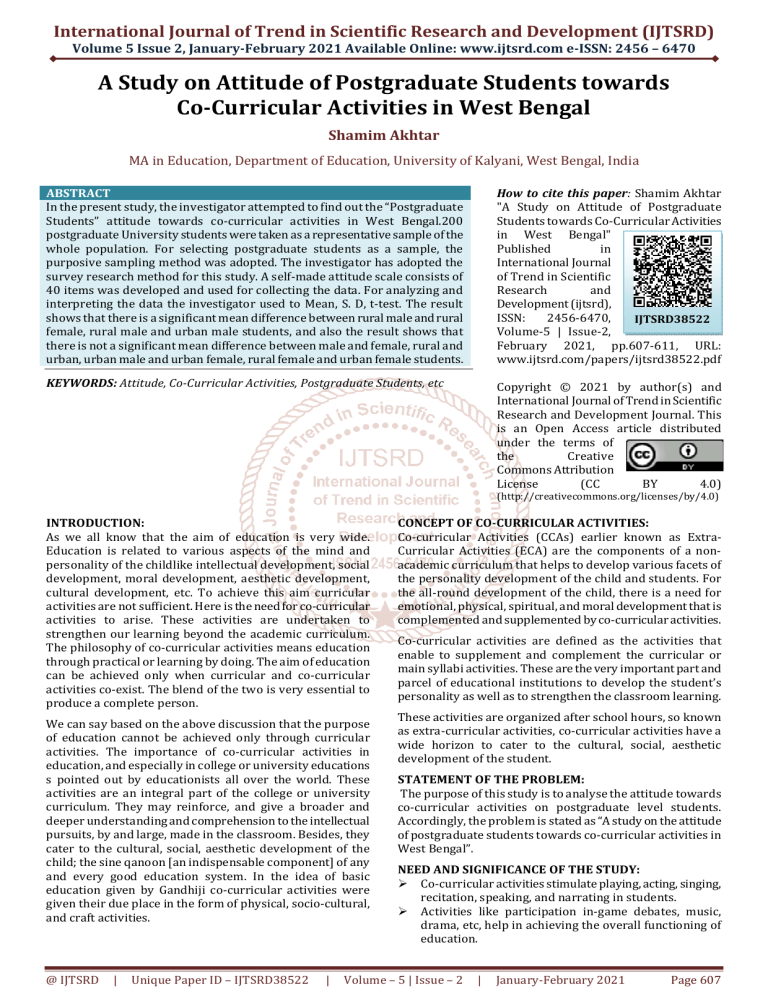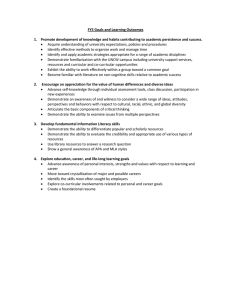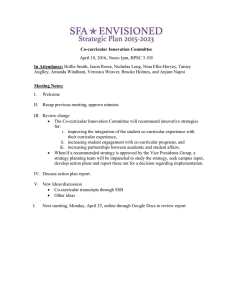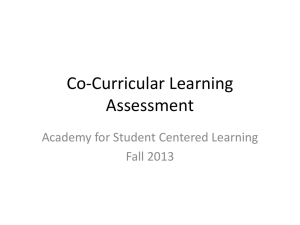
International Journal of Trend in Scientific Research and Development (IJTSRD)
Volume 5 Issue 2, January-February 2021 Available Online: www.ijtsrd.com e-ISSN: 2456 – 6470
A Study on Attitude of Postgraduate Students towards
Co-Curricular Activities in West Bengal
Shamim Akhtar
MA in Education, Department of Education, University of Kalyani, West Bengal, India
ABSTRACT
In the present study, the investigator attempted to find out the “Postgraduate
Students” attitude towards co-curricular activities in West Bengal.200
postgraduate University students were taken as a representative sample of the
whole population. For selecting postgraduate students as a sample, the
purposive sampling method was adopted. The investigator has adopted the
survey research method for this study. A self-made attitude scale consists of
40 items was developed and used for collecting the data. For analyzing and
interpreting the data the investigator used to Mean, S. D, t-test. The result
shows that there is a significant mean difference between rural male and rural
female, rural male and urban male students, and also the result shows that
there is not a significant mean difference between male and female, rural and
urban, urban male and urban female, rural female and urban female students.
How to cite this paper: Shamim Akhtar
"A Study on Attitude of Postgraduate
Students towards Co-Curricular Activities
in West Bengal"
Published
in
International Journal
of Trend in Scientific
Research
and
Development (ijtsrd),
ISSN:
2456-6470,
IJTSRD38522
Volume-5 | Issue-2,
February 2021, pp.607-611, URL:
www.ijtsrd.com/papers/ijtsrd38522.pdf
KEYWORDS: Attitude, Co-Curricular Activities, Postgraduate Students, etc
Copyright © 2021 by author(s) and
International Journal of Trend in Scientific
Research and Development Journal. This
is an Open Access article distributed
under the terms of
the
Creative
Commons Attribution
License
(CC
BY
4.0)
(http://creativecommons.org/licenses/by/4.0)
INTRODUCTION:
As we all know that the aim of education is very wide.
Education is related to various aspects of the mind and
personality of the childlike intellectual development, social
development, moral development, aesthetic development,
cultural development, etc. To achieve this aim curricular
activities are not sufficient. Here is the need for co-curricular
activities to arise. These activities are undertaken to
strengthen our learning beyond the academic curriculum.
The philosophy of co-curricular activities means education
through practical or learning by doing. The aim of education
can be achieved only when curricular and co-curricular
activities co-exist. The blend of the two is very essential to
produce a complete person.
We can say based on the above discussion that the purpose
of education cannot be achieved only through curricular
activities. The importance of co-curricular activities in
education, and especially in college or university educations
s pointed out by educationists all over the world. These
activities are an integral part of the college or university
curriculum. They may reinforce, and give a broader and
deeper understanding and comprehension to the intellectual
pursuits, by and large, made in the classroom. Besides, they
cater to the cultural, social, aesthetic development of the
child; the sine qanoon [an indispensable component] of any
and every good education system. In the idea of basic
education given by Gandhiji co-curricular activities were
given their due place in the form of physical, socio-cultural,
and craft activities.
@ IJTSRD
|
Unique Paper ID – IJTSRD38522
|
CONCEPT OF CO-CURRICULAR ACTIVITIES:
Co-curricular Activities (CCAs) earlier known as ExtraCurricular Activities (ECA) are the components of a nonacademic curriculum that helps to develop various facets of
the personality development of the child and students. For
the all-round development of the child, there is a need for
emotional, physical, spiritual, and moral development that is
complemented and supplemented by co-curricular activities.
Co-curricular activities are defined as the activities that
enable to supplement and complement the curricular or
main syllabi activities. These are the very important part and
parcel of educational institutions to develop the student’s
personality as well as to strengthen the classroom learning.
These activities are organized after school hours, so known
as extra-curricular activities, co-curricular activities have a
wide horizon to cater to the cultural, social, aesthetic
development of the student.
STATEMENT OF THE PROBLEM:
The purpose of this study is to analyse the attitude towards
co-curricular activities on postgraduate level students.
Accordingly, the problem is stated as “A study on the attitude
of postgraduate students towards co-curricular activities in
West Bengal”.
NEED AND SIGNIFICANCE OF THE STUDY:
Co-curricular activities stimulate playing, acting, singing,
recitation, speaking, and narrating in students.
Activities like participation in-game debates, music,
drama, etc, help in achieving the overall functioning of
education.
Volume – 5 | Issue – 2
|
January-February 2021
Page 607
International Journal of Trend in Scientific Research and Development (IJTSRD) @ www.ijtsrd.com eISSN: 2456-6470
It enables the students to express themselves freely
through debates.
Games and sports help to be fit and energetic to the
student.
Helps to develop the spirit of healthy competition.
These activities guide students on how to organise and
present an activity, how to develop skills, how to cooperate and co-ordinate in different situations-all these
helps in leadership qualities.
It provides the avenues of socialization, selfidentification, and self-assessment when the student
comes in content with organisers, fellow participants,
teachers, people outside the college or university during
cultural activity.
Inculcate the values to respects others' views and
feelings.
It makes you perfect in decision making.
It develops a sense of belongingness.
CCA motivates learning.
CCA develops the values like physical, psychological,
Ethical, academic, civic, social aesthetic, cultural
recreational, and disciplinary values.
RESEARCH QUESTION:
What is the difference between male and female
students’ attitudes towards Co-curricular activities?
What is the difference between rural and urban
students’ attitudes towards Co-curricular activities?
What is the difference between rural mail and rural
female students’ attitude towards Co-curricular
activities?
What is the difference between urban male and urban
female students’ attitudes towards Co-curricular
activities?
What is the difference between rural female and urban
female students’ attitudes towards Co-curricular
activities?
what is the difference between rural mail and urban
male students’ attitude towards Co-curricular activities?
OBJECTIVES OF THE STUDY:
To get information about the attitude of postgraduate level
students towards the necessity of Co-curricular activities.
The main purpose of the was:
To find out the attitude of students towards Cocurricular activities.
To find out whether there is any significant difference of
attitude towards Co-curricular activities in male and
female students.
To find out whether there is any significant difference of
attitude towards Co-curricular activities in rural and
urban area's students.
To find out whether there is any significant difference of
attitude towards Co-curricular activities in rural mail
and rural female.
To find out whether there is any significant difference of
attitude towards Co-curricular activities in urban male
and urban female.
To find out whether there is any significant difference of
attitude towards Co-curricular activities in rural females
and urban females.
To find out whether there any significant difference of
attitude towards Co-curricular activities in rural male
and urban male.
@ IJTSRD
|
Unique Paper ID – IJTSRD38522
|
HYPOTHESES OF THE STUDY:
H01: There is no significant difference in attitude toward
co-curricular activities in male and female students.
H02: There is no significant difference in attitude toward
co-curricular activities in rural and urban students.
H03: There is no significant difference in attitude toward
co-curricular activities in rural male and rural female
students.
H04: There is no significant difference in attitude toward
co-curricular activities in urban mail and urban female
students.
H05: There is no significant difference in attitude toward
co-curricular activities in rural female and urban female
students.
H06: There is no significant difference in attitude toward
co-curricular activities in rural male and urban male
students.
REVIEW OF RELATED STUDIES:
Ghoshal. T (2016) The study analysis the attitude of students
towards participation in co-curricular activities and the
attitude of teachers towards co-curricular activities
conducted by the schools. Two self-made questionnaires
were used to collect the data from 720 students of secondary
school in the district of Burdwan, West Bengal. The students
'participation in co-curricular activities differ significantly
According to the teachers view expected and observed trend
of co-curricular activities differ significantly.
Haggar. N. E, Mezhoudi. N and Alrawjin. F (2019)conducted a
study of co-curricular activities refers to the events and
learning skills that take place alongside the academic
curriculum which offers opportunities for the students to
develop specific skills and exhibit their non-academic
abilities which are essential for interacting individually or
collectively in their work and social life. This work has been
conducted along with information technology track,
computer science department, community college, Imam
Abdulrahman bin Faisal University, Dammam, Saudi Arabia.
The results showed that co-curricular activities had great
effects on student’s performance based on these skills.
Kolappan. S (2011) The present study deals with the attitude
of college students towards co-curricular activities who are
doing their graduation under Periyar University, Salem,
Tamil Nadu. The survey method is used for the present
study. The sample selected was 300 students from 8 colleges
under Periyar University, Salem, Tamil Nadu. The college are
selected randomly and the students also. The study reveals
that there are the college students have a a highly positive
attitude towards co-curricular activities, so it is inferred that
the students have awareness about the importance of cocurricular activities in the present educational system.
Singh. C. J (2017) This study is related to teacher trainees
and their co-curricular activities. Co-curricular activities
have been designed in teacher trainee course. The present
study has been conducted by survey method with a selfprepared attitude scale. A sample 229 teacher trainee was
selected through on random basis. Analysis has been done
by t-test. Male and female teacher trainee had similar
attitude towards co-curricular activities, sports, literature
activities, morning assembly, but there was significant
difference in respect of celebration of cultural festivals.
Female teacher trainee have been found to be more positive
attitude than their male counterparts towards celebration
cultural festivals.
Volume – 5 | Issue – 2
|
January-February 2021
Page 608
International Journal of Trend in Scientific Research and Development (IJTSRD) @ www.ijtsrd.com eISSN: 2456-6470
Fang.JTY and Ngee.CH (2013) This study investigated the
teacher attitudes towards co-curricular activities in schools.
The paper aimed to highlight the teacher’s readiness,
knowledge, and commitment towards their involvement in
co-curricular activities in schools. The results of the study
implied that the teacher’s attitude towards the co-curricular
activities influenced significantly the student’s performance
at co-curricular activities.
OPERATIONAL DEFINITION OF KEY TERMS:
Attitude:
The concept of attitude is perhaps the most indispensable
and distinctive in contemporary social psychology. The study
of the concept of attitude is important for psychologists and
particularly social psychologists and sociologists.
All port G.W. has defined attitude as, “a mental and neutral
state of readiness, organised, through experience, exerting a
directive or dynamic influence upon the individual’s
response to all objects and situations with which it is
related.”
METHODOLOGY:
Research Method:
Research Methods are of utmost importance in the research
process. The description is various of the plan of attack to be
adopted in solving research problems, such as how the
problem has formulated the definition of terms, the choice of
subjects for investigations, the validation of data-gathering
tools, the collection analysis and interpretation of data and
the process of inferences are a generalization.
The population of the study:
The students of postgraduate levels were taken as the
population of the study. These students are chosen because
they already completed a bachelor's degree and it is
expected that they have some knowledge of various cocurricular activities.
Sample and Sampling Technique:
A sample is any number of the members of a population that
have been selected to represent the population.
The process of selecting the individuals from a population is
known as sampling.
These are methods of sampling such as purposive sampling
is selected by the investigator.
Collection of Data:
The researcher made his question paper to get dependable
data through solving the problem. The question paper
contained 40 questions. At first, the questions were made
under 4 dimensions. Then the questions were sorted in a
definite order.
Then they kept 5 options of each question for the
convenience of the students like strongly agree, agree,
unknown, disagree, and strongly disagree. Then the kept
blank squares beside the options. Where the student has to
answer with () this sign. In this way, the researcher went to
University with the opinion of the student to come to the
right decision.
Scoring Procedure:
The scoring pattern given by the authors is a self-evaluation
question of 40 statements in which 35 positive and 5
negative responses.
The subject responds to each student using a five-point liker
scale varying from.
@ IJTSRD
|
Unique Paper ID – IJTSRD38522
|
1.
2.
3.
4.
5.
(Strongly agree with the negative statement and
strongly disagree with the positive statement.)
(Agree for the negative statement and disagree for the
positive statement.)
(Unknown for the negative and positive statement.)
(Agree for the positive statement and disagree for the
negative statement.)
(Strongly agree with the positive statement and strongly
disagree with the negative statement.)
Variable of the study:
The rate of the variable is always is changeable. Every work
of research depends on this variable. The investigator
decides based on this rate. The variable is essential in the
field of any kind of research. The variable in the problem is
solving by the investigator.
There are two types of variable, In the one hand is the
independent variable, on the other hand, is the dependent
variable.
A. Independent Variable:
The following independent variables were considered in the
study:
Areas(Rural and Urban)
Gender(Male and Female)
B. Dependent variable:
The following dependent variables were considered for the
study:
The moral values of the students.
C. Intervening variable:
The following intervening was considered in the study:
Learner variable
University variable
Home environment.
ANALYSIS AND INTERPRETATION:
In this chapter, the data present study that was collected
using the procedure mention in the previous chapter has
been present. Statistical analysis of data results obtained out
of the analysis of data interpretation of results in the light of
available knowledge, and testing of hypothesis has also been
presented in this chapter.
Presentation of Data:
The researcher took 200 types of research work to drive his
research of A study on the attitude of postgraduate
students towards co-curricular activities in West Bengal.
In his work, there are 100 students from the urban area, 50
male and 50 female, and 100 students from rural areas 50
male and 50 females. The researcher noticed the norm of his
work and he uses a specific question bunch on 200 students.
He made this table on the mean and SD to arrive at this
purpose of research.
Table 1: Showing number of student’s means and
standard Deviation of students score:
Group
Number Mean
SD
Total Male
100
139.14 23.90
Total Female
100
135.17 17.97
Total Rural
100
138.8 22.31
Total Urban
100
135.51 19.79
Rural Male
50
143.86 27.20
Urban Male
50
131.8 19.36
Rural Female
50
133.74 14.51
Urban Female
50
136.32 20.54
Volume – 5 | Issue – 2
|
January-February 2021
Page 609
International Journal of Trend in Scientific Research and Development (IJTSRD) @ www.ijtsrd.com eISSN: 2456-6470
Table 2: Comparison of attitude between male and
female postgraduate-level students
Group
Number Mean
SD
t-value
Total male
100
139.14 23.90
students
1.33
Total female
100
135.17 17.97
students
Significance at 0.05 level
Table 5: Comparison of attitude between urban male
and urban female post-graduate-level students
Group
Number Mean
SD
t-value
Urban male
50
131.8 19.36
students
1.12
Urban female
50
136.32 20.54
students
Significance at 0.05 level
Analysis:
The finding of the 't' value has revealed here a statistically
significant difference (t=1.33) between male and female
post-graduate-level students. This is significant and the 't'
value indicates that there is a remarkable difference between
these two groups under the study.
Analysis:
The finding of the 't' value has revealed here a statistically
significant difference (t=1.12) between urban male and
urban female post-graduate-level students. This is significant
and the ’t’ value indicates that there is a remarkable
difference between these two groups under the study.
Interpretation:
Based on the above finding of the first null hypothesis (H01)
is accepted. It means that there is not a significant mean
difference between male and female students’ attitudes
towards Co-curricular Activities.
Interpretation:
Based on the above finding of the first null hypothesis (H04)
is accepted. It means that there is not a significant mean
difference between urban male and urban female students’
attitudes towards Co-curricular Activities.
Table 3: Comparison of attitude between rural and
urban postgraduate-level students
Group
Number Mean
SD
t-value
Total rural
100
138.8 22.31
students
1.10
Total urban
100
135.51 19.79
students
Significance at 0.05 level
Table 6: Comparison of attitude between rural female
and urban female postgraduate-level students
Group
Number Mean
SD
t-value
Rural female
50
133.74 14.51
students
0.71
Urban female
50
136.32 20.54
students
Significance at 0.05 level
Analysis:
The finding of the 't' value has revealed here a statistically
significant difference (t=1.10) between rural and urban postgraduate-level students. This is significant and the 't' value
indicates that there is a remarkable difference between these
two groups under the study.
Analysis:
The finding of the 't' value has revealed here a statistically
significant difference (t=0.71) between rural female and
urban female post-graduate-level students. This is significant
and the 't' value indicates that there is a remarkable
difference between these two groups under the study.
Interpretation:
Based on the above finding of the first null hypothesis (H02)
is accepted. It means that there is not a significant mean
difference between rural and urban students’ attitudes
towards Co-curricular Activities.
Interpretation:
Based on the above finding of the first null hypothesis (H05)
is accepted. It means that there is not a significant mean
difference between rural female and urban female students’
attitudes towards Co-curricular Activities.
Table 4: Comparison of attitude between rural male
and rural female post-graduate-level students
Group
Number Mean
SD
t-value
Rural male
50
143.86 27.20
students
2.32
Rural female
50
133.74 14.51
students
Significance at 0.05 level
Table 7: Comparison of attitude between rural male
and urban male post-graduate-level students
Group
Number Mean
SD
t-value
Rural male
50
143.86 27.20
students
1.99
Urban male
50
131.8 19.36
students
Significance at 0.05 level
Analysis:
The finding of the 't' value has revealed here a statistically
significant difference (t=2.32) between rural male and rural
female postgraduate-level students. This is significant and
the 't' value indicates that there is a remarkable difference
between these two groups under the study.
Analysis:
The finding of the 't' value has revealed here a statistically
significant difference (t=1.99) between rural male and urban
male postgraduate-level students. This is significant and the
't' value indicates that there is a remarkable difference
between these two groups under the study.
Interpretation:
Based on the above finding of the first null hypothesis (H03)
is rejected. It means that there is a significant mean
difference between rural male and rural female students’
attitudes towards Co-curricular Activities.
Interpretation:
Based on the above finding of the first null hypothesis (H06)
is rejected. It means that there is a significant mean
difference between rural male and urban male students’
attitudes towards Co-curricular Activities.
@ IJTSRD
|
Unique Paper ID – IJTSRD38522
|
Volume – 5 | Issue – 2
|
January-February 2021
Page 610
International Journal of Trend in Scientific Research and Development (IJTSRD) @ www.ijtsrd.com eISSN: 2456-6470
FINDINGS OF THE STUDY:
As the computed value was not significant and the null
hypothesis (H01) accepted. So, it can be interpreted that
there is no significant mean difference between male
and female students in Co-curricular activities.
As the computed value was not significant and the null
hypothesis (H02) accepted. So, it can be interpreted that
there is no significant mean difference between rural
and urban students in Co-curricular activities.
As the computed value was significant and the null
hypothesis (H03) rejected. So, it can be interpreted that
there is a significant mean difference between rural
male and rural female students in Co-curricular
activities.
As the computed value was not significant and the null
hypothesis (H04) accepted. So, it can be interpreted that
there is no significant mean difference between urban
male and urban female students in Co-curricular
activities.
As the computed value was not significant and the null
hypothesis (H05) accepted. So, it can be interpreted that
there is no significant mean difference between rural
female and urban female students in Co-curricular
activities.
As the computed value was significant and the null
hypothesis (H06) rejected. So, it can be interpreted that
there is a significant mean difference between rural
male and urban male students in Co-curricular activities.
CONCLUSION:
After the Research work Researcher come to this point, there
is not a significant mean difference between male and female
students towards co-curricular activities. There is not a
significant mean difference between rural and urban
students towards co-curricular activities. In the rural area,
there is a significant mean difference between male and
female students’ co-curricular activities. In the urban area,
there is not a significant mean difference between male and
female students towards co-curricular activities. There is not
a significant mean difference between rural female and
urban female students towards co-curricular activities.
There is a significant mean difference between rural male
and urban male students towards co-curricular activities.
@ IJTSRD
|
Unique Paper ID – IJTSRD38522
|
REFERENCES:
[1] Best and Kahn (2014). Research in Education, PHI
Learning, Dehli 110092.
[2] Creswell, J. W. (2012). Educational Research:
Planning, Conducting and Evaluating Quantitative and
Qualitative Research (4th ed.). 501 Boylston Street,
Boston: Pearson Education.
[3] Fang.JTY and Ngee.CH (2013). Teachers Attitude
towards Co-Curricular Activities in Selected Schools.
Journal of Research, Policy and Practice of Teachers
and Teacher Education, 3(2), 60-70.
[4] Garrett, H. E. (1979). STATISTICS IN PSYCHOLOGY
AND EDUCATION (6th ed.). Bombay: G. U. Mehta.
[5] Gay, L. R. Mills, G. E and Airasian, P. W. (2017).
Educational Research, Competencies for Analysis and
Application (10th Edition) Pearson.
[6] Ghoshal. T. (2016). A Study on Co-Curricular
Activities at Secondary Level. International Journal in
Management and Social Science, 4(9), 46-54.
[7] Haggar. N. E, Mezhoudi. N and Alrawjin. F. (2019) the
Impact of Co-Curricular Activities Supported by
Generic Skills on Students Performance at University
Level. International Journal of Innovative Technology
and Exploring Engineering, 8(12), 981-986.
[8] Kolappan. S. (2011). Attitude of College Students
towards Co-Curricular Activities. International Journal
of Human Resource Management Research and
Development, 1(2), 10-18.
[9] Kothari, C. R (1990). Research Methodology, Methods
and Techniques, New Age International Publishers,
New Delhi-110002.
[10] Koul, L. (2017). Methodology of Educational Research,
Vikas Publishing House Pvt. Ltd.
[11] Mangal, S. K. (2014). Statistics in Psychology and
Education (2nd Ed.). Delhi: PHI Learning Private
Limited.
[12] Mangal, S. K. & Mangal, S. (2018) Research
Methodology in Behavioural Sciences, PHI Learning
Pvt. Ltd. Delhi 110092.
[13] Singh. C. J. (2017). Attitude of Teacher Trainees
towards Co-Curricular Activities. International
Educational Journal, 114-125.
Volume – 5 | Issue – 2
|
January-February 2021
Page 611



